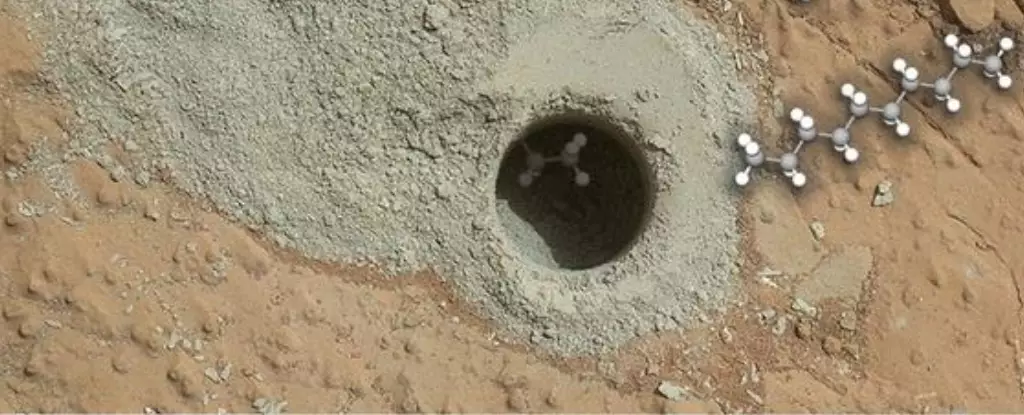In a groundbreaking revelation, scientists have unveiled the existence of chain-like structures composed of carbon atoms on Mars, remnants traced back to an ancient lakebed. This remarkable finding, powered by the diligent efforts of NASA’s Curiosity rover, adds another layer to the rich tapestry of potential life on the red planet. Led by the expertise of Caroline Freissinet from France’s CNRS, the research team has confirmed these molecules in a controlled lab environment on Earth, signaling a profoundly significant leap in our understanding of Mars’ geological and biological history.
But what does this really mean for humanity? The existence of carbon chains—particularly those as lengthy as decane, undecane, and dodecane—could indicate that life forms, however primitive, once roamed the Martian terrain. The discovery raises questions not just about the possibility of life on Mars but about our place in the universe. Could our neighboring planet have harbored life that went extinct, leaving behind these molecular echoes? Or are these compounds merely the result of non-biological processes? The implications are staggering, powerful enough to ignite conversations about humanity’s future and role as stewards of life across the cosmos.
The Search for Biosignatures: A New Frontier
The Curiosity rover was designed with the primary objective of uncovering evidence of past life on Mars. As it maneuvers through the Gale crater, it continuously stumbles upon peculiar deposits of minerals, which include chlorinated compounds and nitrates. These findings have propelled researchers to ponder whether even more complex indicators of life exist within the ancient strata. This endeavor is not merely an academic exercise; it signifies humanity’s desire to comprehend our origins and whether we are alone in the vast universe.
Laboratory experiments that replicated the Martian environment revealed something mesmerizing: these carbon chains might arise from simple chemicals like hydrogen and carbon monoxide, devoid of any biological influence. But, let’s contemplate what this truly signifies. The fact that our scientific community is braving this venture, tirelessly peeling back layers of Martian soil in search of life, is a testament to our innate curiosity—a beautiful flaw when considering the existential threats we face on Earth. Why are we fixated on the ashes of former lives on another planet? It reflects our unquenchable thirst for answers beyond the confines of Earth.
Abiotic vs. Biotic: The Eternal Debate
While some might attribute these carbon compounds to abiotic processes, there’s a whimsical urge to entertain the possibility of an ancient Martian ecosystem thriving under its rusty surface. After all, many carboxylic acids, which dominated the essence of life on Earth, are also present in the Martian samples. This synergy between the carbon structures and potential biochemistry opens up a dialogue that teeters on the brink of optimism and caution. As scientists rumble forth in their investigations, they lay a foundation for understanding chemistry across worlds—one that might challenge our dogmas about what constitutes life.
However, this exploration is a double-edged sword; while it sparks wonderment, it also highlights our limited capability to comprehend the universe’s broader narrative. We’re guilty of anthropomorphizing exalted visions of extraterrestrial life when, in truth, we might just be staring into the mirror of our own biology reflected in the cosmos. The Mars missions are more than a quest for life; they serve as a lens through which we can examine our myriad ecological challenges.
The Road Ahead: Future Missions and the Pursuit of Knowledge
This exciting finding accentuates the need for further missions to Mars. While we are just scratching the surface of Martian chemistry, the revelations from the Curiosity rover should fuel our motivations to develop newer technologies that can delve deeper into Martian rock and ice reservoirs, where water might still flow and life could persist, albeit in hidden forms. It also paves the way for public support and collaboration that extends across the scientific community globally.
Yet amidst the zeal, we must remain grounded. The search for life on planets outside of Earth also comes with an ethical responsibility—a sense of guardianship for discoveries yet to be made. Are we ready to confront the profound implications? What would it mean for us as Earthlings if we found life elsewhere or, conversely, if our search came up empty? Each mission, each finding, serves not just as a scientific endeavor but also as a monumental chapter in our shared human narrative, urging us toward greater care for our planet and endless curiosity for the universe.

